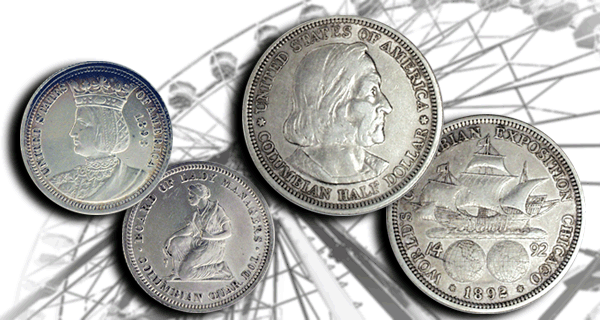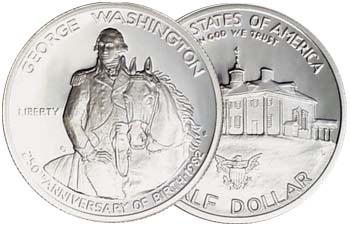
The 1893 World’s Fair in Chicago introduced the American public to not only the first U.S. commemorative coin, but also to the first Ferris wheel.
Commemorative coins were used by the ancient Greeks and Romans to record important events and pass along news of the time; they often recorded the victors of battles and new rulers. For example, large denomination decadrachms are thought to have been issued for significant events; particularly of Greece’s victory over Persia in 480-479 B.C. Today, commemorative coins are issued by many nations and nearly always chronicle important people, places or historical events.
U.S. commemorative coins fall into two time periods: Classic (1892-1954) and Modern (1982-present). Authorized by the U.S. Mint, some of America’s finest artists and sculptors designed unique coins not found in circulation. Profits generated from sales of these coins generally funded specific events and interests related to the theme. Early on, commemoratives had a narrow scope of appeal; they were often regionally specific and low mintage numbers made them difficult to obtain. When the U.S. Mint hit its commemorative stride in the 1980s, a greater variance of themes and availability led to universal interest.
Not So Popular First Attempt
The 1893 World’s Columbian Exposition held in Chicago celebrated the 400th anniversary of Columbus’ inadvertent discovery of the New World. To mark the event, the United States issued the first commemorative coin, the silver 1892-1893 Columbian half dollar. It was sold for $1 and was engraved by both artistic powerhouses of the day, Charles E. Barber and George T. Morgan. The obverse, engraved by Barber, depicted a bust of Columbus; while the reverse displayed the work of Morgan: Columbus’ ship the Santa Maria and earth’s two hemispheres.
 Also issued at the fair was a souvenir that sold for $1; the 1893 Isabella quarter, commissioned by the Board of Lady Managers at Exposition. The quarter represented women’s contributions to industry in the time of Columbus. Engraved by Barber, its obverse depicted Columbus’ financier, the Spanish Queen Isabella and an idealized figure of a woman spinner. Just over 24,000 were minted.
Also issued at the fair was a souvenir that sold for $1; the 1893 Isabella quarter, commissioned by the Board of Lady Managers at Exposition. The quarter represented women’s contributions to industry in the time of Columbus. Engraved by Barber, its obverse depicted Columbus’ financier, the Spanish Queen Isabella and an idealized figure of a woman spinner. Just over 24,000 were minted.
Both early American commemoratives proved unpopular with the general public, presumably patrons of the fair balked at paying three times face value for a quarter. Many ended up in the melting pot, or in the case of the Isabellas, the majority were bought back by the Board of Lady Managers. Just 110 years later in 2013, a Certified MS-68 Queen Isabella quarter sold at auction for over $64,000!
Stalled Out
Although the U.S. mint kept plugging away, commemoratives took a while to catch on in popularity. Many classic commemoratives celebrated states or even cities, but outside of those geographical areas, they did not have broad appeal. Did you know that P.T. Barnum appeared on an official U.S. coin? In 1936, Bridgeport, Connecticut posthumously honored one of its most famous residents, the greatest showman – P.T. Barnum.
 After the last Carver/Washington coin was struck in 1954, commemoratives were not minted again until 1982. By this time, all silver content had been removed from American Coinage. In 1982, the George Washington commemorative silver half dollar emerged and was the first coin to contain 90% silver since 1964.
After the last Carver/Washington coin was struck in 1954, commemoratives were not minted again until 1982. By this time, all silver content had been removed from American Coinage. In 1982, the George Washington commemorative silver half dollar emerged and was the first coin to contain 90% silver since 1964.
Something for Everyone
Today, the broad range of subjects and themes of commemorative coins appeals to a wide range of collectors. With the exception of 1985, the U.S. Mint has released at least one commemorative coin every year since Washington’s debut.
Many modern issues have more than one denomination. Half dollars are typically clad, while dollars are 90% silver and some are even minted as $5 or $10 gold pieces. Most designs also have a proof version. Regardless of their face value, all commemorative coins have limited mintages. Once the U.S. mint reaches its quota for a particular design, it will never be produced again. Some earlier modern commemoratives had mintages of over 2 million, while 2017’s Boys Town silver dollar had a mintage of just over 12,000.
Where to Go From Here
Really, they sky’s the limit. Some collectors are up for the challenge of obtaining every release since 1982 (or from 1892!). Others only collect commemoratives relating to America’s military history. There are many different coins celebrating Olympic events. With 35 years of production, there truly is a modern commemorative coin for everyone. Mark Twain said, “The secret of getting ahead is getting started.” And yes, there’s even a commemorative coin in his honor.

This article was very interesting history about Commemorative coins in the United States .